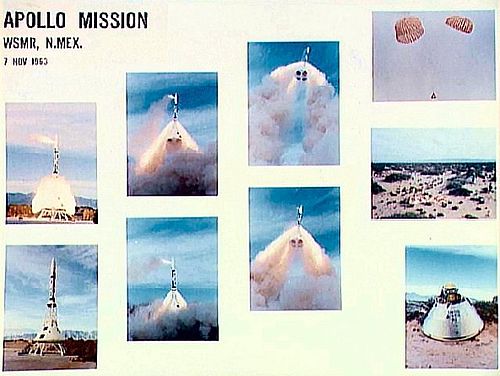.gif)
Pad Abort Test-1 (Apollo)
Encyclopedia
Pad Abort Test 1 was the first abort test
of the Apollo spacecraft on November 7, 1963.
The flight featured a production model LES and a boilerplate (BP-6) Apollo spacecraft, the first mission to feature one. The spacecraft carried no instruments for measuring structural loads as the capsule's boilerplate structure did not represent that of a real spacecraft.
 On November 7, 1963, an abort signal was sent to the LES at 09:00:01 local time. This initiated a sequence in which the main solid rockets fired to move the spacecraft and smaller attitude rockets fired so that the spacecraft moved laterally (at Cape Canaveral
On November 7, 1963, an abort signal was sent to the LES at 09:00:01 local time. This initiated a sequence in which the main solid rockets fired to move the spacecraft and smaller attitude rockets fired so that the spacecraft moved laterally (at Cape Canaveral
this lateral movement would be toward the ocean
).
The LES separated after fifteen seconds with the spacecraft now on a ballistic
trajectory
. The parachute system worked perfectly with the drogue chute stabilizing the spacecraft, followed by the three main parachutes that slowed the descent to a leisurely 26 kilometers per hour.
The only problems found with the flight were that the LES rockets had left a soot
deposit on the spacecraft exterior and the stability of the spacecraft was less than predicted.

Pad abort test
A pad abort test is a test of a launch escape system to determine how well the system could get the crew of a spacecraft to safety in an emergency on the launch pad.- Project Mercury :Section sources....
of the Apollo spacecraft on November 7, 1963.
Objectives
Pad Abort Test 1 was a mission to investigate the effects on the Apollo spacecraft during an abort from the pad. The launch escape system (LES) had to be capable of pulling the spacecraft away from a possibly exploding rocket while it sat on the pad. The LES then had to gain enough altitude to allow the command module's parachutes to open, preferably with the spacecraft over water and not land.The flight featured a production model LES and a boilerplate (BP-6) Apollo spacecraft, the first mission to feature one. The spacecraft carried no instruments for measuring structural loads as the capsule's boilerplate structure did not represent that of a real spacecraft.
Flight

Cape Canaveral
Cape Canaveral, from the Spanish Cabo Cañaveral, is a headland in Brevard County, Florida, United States, near the center of the state's Atlantic coast. Known as Cape Kennedy from 1963 to 1973, it lies east of Merritt Island, separated from it by the Banana River.It is part of a region known as the...
this lateral movement would be toward the ocean
Ocean
An ocean is a major body of saline water, and a principal component of the hydrosphere. Approximately 71% of the Earth's surface is covered by ocean, a continuous body of water that is customarily divided into several principal oceans and smaller seas.More than half of this area is over 3,000...
).
The LES separated after fifteen seconds with the spacecraft now on a ballistic
Ballistics
Ballistics is the science of mechanics that deals with the flight, behavior, and effects of projectiles, especially bullets, gravity bombs, rockets, or the like; the science or art of designing and accelerating projectiles so as to achieve a desired performance.A ballistic body is a body which is...
trajectory
Trajectory
A trajectory is the path that a moving object follows through space as a function of time. The object might be a projectile or a satellite, for example. It thus includes the meaning of orbit—the path of a planet, an asteroid or a comet as it travels around a central mass...
. The parachute system worked perfectly with the drogue chute stabilizing the spacecraft, followed by the three main parachutes that slowed the descent to a leisurely 26 kilometers per hour.
The only problems found with the flight were that the LES rockets had left a soot
Soot
Soot is a general term that refers to impure carbon particles resulting from the incomplete combustion of a hydrocarbon. It is more properly restricted to the product of the gas-phase combustion process but is commonly extended to include the residual pyrolyzed fuel particles such as cenospheres,...
deposit on the spacecraft exterior and the stability of the spacecraft was less than predicted.
Gallery


